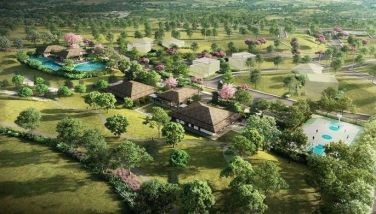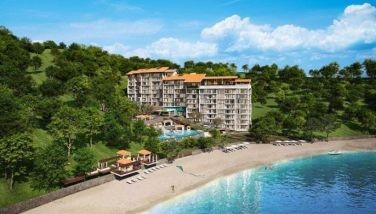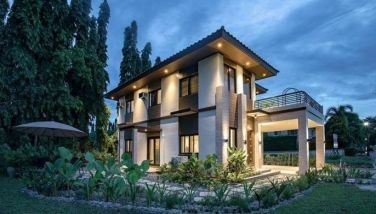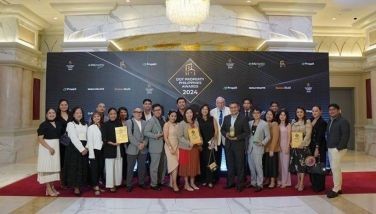BFAR introduces seaweed farming to Luzon fishermen
July 11, 2004 | 12:00am
Because of a steadily increasing demand for seaweeds both locally and abroad for food and industrial uses and the need to provide a profitable alternative livelihood to fishermen in Luzon, the Bureau of Fisheries and Aquatic Resources has introduced seaweed farming in non-traditional areas like Dasol, Pangasinan and to La Union and Ilocos provinces in the near future.
BFAR Director Malcolm I. Sarmiento Jr. said the country’s production of one million metric tons is barely enough to supply the requirements of seven processing plants that make use of the seaweed extracts for processing into industrial products like pharmaceutical, cosmetics, food and other applications or exported as extract to the world market.
Around 87,000 metric tons of dried seaweeds or extracts are exported to foreign markets, Sarmiento said.
The Philippines is the third largest producer/supplier of seaweeds in the world after China and Japan. For the past seven years, however, the Philippines remained as the top supplier of carageenan, a gelling agent used extensively as thickener or emulsifier in almost every commercial products from medicine, toothpaste, ice cream, chocolate, cosmetics or even beer.
To date, seaweed production is heavily concentrated in the ARMM contributing half of the country’s seaweeds output, Sarmiento said.
Of the total mariculture farms devoted to seaweeds in the country, 56 percent are located in Mindanao and the balance is mostly in the Visayas and Palawan.
BFAR only recently launched the lantay bed technology in initially 180 hectares of potential seaweed farms in the coastal communities of Dasol, Pangasinan by putting up a seaweed nursery in Dasol where fishfarmers can obtain their seedlings for propagation in the mariculture ecozone there. The goal is to increase this to 1,000 hectares by next year. The launch was led by Agriculture Secretary Luis Lorenzo Jr. and Rep. Arthur Celeste. The 180 hectares will employ 1,000 fishermen, Sarmiento said.
The lantay bed is designed such that it could withstand rough sea water. This year, BFAR plans to put up 80 seaweed nurseries in non-traditional areas in addition to its existing 102 nurseries to ensure steady supply of quality seedlings nationwide.
Lorenzo directed the BFAR and officials of the Marine Colloid Seaweed in the Philippines Inc. (MCSPI) led by Maximo Ricohermoso to update jointly the development roadmap, which spells out the strategy in pursuing the country’s goal of becoming the world’s premier seaweed producer/supplier. One such strategy is putting up seaweed nurseries and grow-out centers nationwide.
The lantay technology was perfected by the MCSPI in Cebu which makes it possible to grow seaweeds in rough seas like those in Ilocos coast, Pangasinan, La Union and the western and northern side of Luzon, Sarmiento said.
Under the seaweeds commodity roadmap, BFAR is aiming for increased seaweed production by setting up 80 more nurseries that would produce an additional 151,000 metric tons and benefit 1,820 farm families or 9,100 individuals nationwide.
BFAR Director Malcolm I. Sarmiento Jr. said the country’s production of one million metric tons is barely enough to supply the requirements of seven processing plants that make use of the seaweed extracts for processing into industrial products like pharmaceutical, cosmetics, food and other applications or exported as extract to the world market.
Around 87,000 metric tons of dried seaweeds or extracts are exported to foreign markets, Sarmiento said.
The Philippines is the third largest producer/supplier of seaweeds in the world after China and Japan. For the past seven years, however, the Philippines remained as the top supplier of carageenan, a gelling agent used extensively as thickener or emulsifier in almost every commercial products from medicine, toothpaste, ice cream, chocolate, cosmetics or even beer.
To date, seaweed production is heavily concentrated in the ARMM contributing half of the country’s seaweeds output, Sarmiento said.
Of the total mariculture farms devoted to seaweeds in the country, 56 percent are located in Mindanao and the balance is mostly in the Visayas and Palawan.
BFAR only recently launched the lantay bed technology in initially 180 hectares of potential seaweed farms in the coastal communities of Dasol, Pangasinan by putting up a seaweed nursery in Dasol where fishfarmers can obtain their seedlings for propagation in the mariculture ecozone there. The goal is to increase this to 1,000 hectares by next year. The launch was led by Agriculture Secretary Luis Lorenzo Jr. and Rep. Arthur Celeste. The 180 hectares will employ 1,000 fishermen, Sarmiento said.
The lantay bed is designed such that it could withstand rough sea water. This year, BFAR plans to put up 80 seaweed nurseries in non-traditional areas in addition to its existing 102 nurseries to ensure steady supply of quality seedlings nationwide.
Lorenzo directed the BFAR and officials of the Marine Colloid Seaweed in the Philippines Inc. (MCSPI) led by Maximo Ricohermoso to update jointly the development roadmap, which spells out the strategy in pursuing the country’s goal of becoming the world’s premier seaweed producer/supplier. One such strategy is putting up seaweed nurseries and grow-out centers nationwide.
The lantay technology was perfected by the MCSPI in Cebu which makes it possible to grow seaweeds in rough seas like those in Ilocos coast, Pangasinan, La Union and the western and northern side of Luzon, Sarmiento said.
Under the seaweeds commodity roadmap, BFAR is aiming for increased seaweed production by setting up 80 more nurseries that would produce an additional 151,000 metric tons and benefit 1,820 farm families or 9,100 individuals nationwide.
BrandSpace Articles
<
>
- Latest
Latest
Latest
October 23, 2024 - 9:30am
By May Dedicatoria | October 23, 2024 - 9:30am
October 11, 2024 - 3:45pm
October 11, 2024 - 3:45pm
October 10, 2024 - 11:30am
October 10, 2024 - 11:30am
October 5, 2024 - 12:08pm
October 5, 2024 - 12:08pm
September 24, 2024 - 1:00pm
September 24, 2024 - 1:00pm
September 13, 2024 - 4:00pm
September 13, 2024 - 4:00pm
Recommended






























